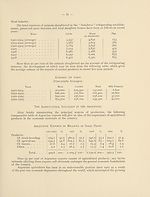Download files
Complete book:
Individual page:
Thumbnail gallery: Grid view | List view

— 8o
Industrial Crops.
Linseed.
The Argentine ranks first among countries producing and exporting linseed and
supplies 76 per cent of the world consumption.
Linseed-growing in the Argentine
Year
1909-IO
I924_25
1925- 26
1926- 27
1927- 28
1928- 29
1929- 3°
1930- 31
Area under
cultivation
(thousands of
hectares)
Total production
(thousands of
tons)
1,276
2,559
2,509
2,950
2,855
2,953
2,900
2,995
716
IT45
1,098
1,755
2,Ol8
2,103
1,402
Yield per
hectare
(Kg.)
561
447
761
650
706
712
Vines.
Vine-growing dates from the Colonial period, but has only acquired predominant
importance in the last 50 years in the Andes. The area under cultivation is 130,000 hectares,
with an average crop of 8 million quintals of grapes yearly, and a wine production which,
in 1928-29, reached 8,200,000 hectolitres.
Cotton.
Rational cotton-growing is of recent date and of relatively small importance. During
the war, however, it extended rapidly. The exploitation of this new source of wealth is due
to the good prices obtained during the war, and to the undoubted suitability of large areas
of the Republic to the cultivation of this plant.
The production of raw cotton has varied in recent years between 80,000 and
100,000 tons.
Stock-breeding.
Stock-breeding is another important factor in the economic structure of the country,
on account of the high degree of perfection to which the native breeds have been brought
and the development of the refrigerating industry for the preservation and transport
of the meat.
The products of stock-breeding represent 37 per cent of all Argentine exports.
The Argentine occupies the fourth place in the world in absolute figures for live-stock,
while it ranks first, with a large margin, as an exporter of animal products.
According to the census carried out in June 1930, the figures for live-stock are as
follows:
Number
Cattle 31,973,802
Sheep 43,083,909
Horses 9,839,463
Pigs 3,763,393
Industrial Crops.
Linseed.
The Argentine ranks first among countries producing and exporting linseed and
supplies 76 per cent of the world consumption.
Linseed-growing in the Argentine
Year
1909-IO
I924_25
1925- 26
1926- 27
1927- 28
1928- 29
1929- 3°
1930- 31
Area under
cultivation
(thousands of
hectares)
Total production
(thousands of
tons)
1,276
2,559
2,509
2,950
2,855
2,953
2,900
2,995
716
IT45
1,098
1,755
2,Ol8
2,103
1,402
Yield per
hectare
(Kg.)
561
447
761
650
706
712
Vines.
Vine-growing dates from the Colonial period, but has only acquired predominant
importance in the last 50 years in the Andes. The area under cultivation is 130,000 hectares,
with an average crop of 8 million quintals of grapes yearly, and a wine production which,
in 1928-29, reached 8,200,000 hectolitres.
Cotton.
Rational cotton-growing is of recent date and of relatively small importance. During
the war, however, it extended rapidly. The exploitation of this new source of wealth is due
to the good prices obtained during the war, and to the undoubted suitability of large areas
of the Republic to the cultivation of this plant.
The production of raw cotton has varied in recent years between 80,000 and
100,000 tons.
Stock-breeding.
Stock-breeding is another important factor in the economic structure of the country,
on account of the high degree of perfection to which the native breeds have been brought
and the development of the refrigerating industry for the preservation and transport
of the meat.
The products of stock-breeding represent 37 per cent of all Argentine exports.
The Argentine occupies the fourth place in the world in absolute figures for live-stock,
while it ranks first, with a large margin, as an exporter of animal products.
According to the census carried out in June 1930, the figures for live-stock are as
follows:
Number
Cattle 31,973,802
Sheep 43,083,909
Horses 9,839,463
Pigs 3,763,393
Set display mode to:
![]() Universal Viewer |
Universal Viewer | ![]() Mirador |
Large image | Transcription
Mirador |
Large image | Transcription
Images and transcriptions on this page, including medium image downloads, may be used under the Creative Commons Attribution 4.0 International Licence unless otherwise stated. ![]()
| League of Nations > Economic and financial section > Agricultural crisis > Volume 1 > (82) |
|---|
| Permanent URL | https://digital.nls.uk/190903716 |
|---|
| Shelfmark | LN.II.2/2.(35) |
|---|---|
| Attribution and copyright: |
|
| Shelfmark | LN.II.2/2.(35-35) |
|---|---|
| Shelfmark | LN.II |
|---|
| Description | Over 1,200 documents from the non-political organs of the League of Nations that dealt with health, disarmament, economic and financial matters for the duration of the League (1919-1945). Also online are statistical bulletins, essential facts, and an overview of the League by the first Secretary General, Sir Eric Drummond. These items are part of the Official Publications collection at the National Library of Scotland. |
|---|---|
| Additional NLS resources: |
|

